Flower Dissection Lab
Flower Dissection Lab
Flower Dissection Lab
- No tags were found...
You also want an ePaper? Increase the reach of your titles
YUMPU automatically turns print PDFs into web optimized ePapers that Google loves.
Name _______________________________________________________Date _______________________Class ________________________LAB PROGRAMINQUIRY SKILLSB15<strong>Flower</strong> StructuresHRW material copyrighted under notice appearing earlier in this work.SkillsObjectives• dissecting flowers• identifying flower parts• Identify the structures and arrangements of the female and male reproductiveorgans of the flower.• Compare and contrast sepals and petals.Materials • gloves • microscope slidePurposeBackgroundProcedure• monocot flower (gladiolus, tulip, or lily)or dicot flower (azalea, camelia, eveningprimrose, morning glory, or snapdragon)• hand lens• sheet of white paper• transparent tape• coverslip• compound light microscope• water• dissecting needle• dropping pipet• scalpelIn this lab, you will examine a typical flower and observe the parts adapted forthe production and protection of seeds.Every flower consists of a set of adaptations that help to ensure successful reproduction.For example, flowers often have bright colors, attractive shapes, andpleasing aromas. These traits help them attract insects and other animals thatwill carry pollen grains from flower to flower. Pollination also occurs by meansother than animals carrying the pollen. For some flowering plants, the wind plays animportant role in transferring pollen from plant to plant.The seed-bearing plants that produce flowers are angiosperms. The flower producesthe seeds, each of which contains a new plant embryo. The parts of the flower areusually found in four whorls, or rings. Petals are one of the four whorls. Theyattract pollinators. Sepals lie outside the petals. They protect the bud.The reproductive organs, the stamens and pistils, make up the third and fourthwhorls and lie inside the petals. A stamen is a male reproductive part. It consistsof an anther that is held up by a filament. The anther produces pollen grains.A pistil is a female reproductive part. Its top is called the stigma. It is sticky toensure that when pollen grains land on it, they stick to it. The middle supportingstructure is the style, and the large base is the ovary, where the eggs are produced.Part 1—Examining <strong>Flower</strong> Parts1. Put on gloves. Examine a sample flower with a hand lens. As youlook at the center of your flower, be careful not to damage anyparts. Notice how the parts are arranged in circles and attached at the flowerbase. CAUTION: Some fluids from plants are irritating to the skin. Be sure towear gloves when handling such plants. Keep your hands away from your face.HOLT BIOSOURCES <strong>Lab</strong> Program: Inquiry Skills B15 69
INQUIRY SKILLS B15continued2. Use the diagram below to help locate the sepals. The ring of sepals is calledthe calyx. In the table below, record the number of sepals in your flower,describe their appearance, and note the presence or absence of an odor.PistilStigmaStyleOvaryAntherStamenFilamentPetalsOvuleReceptacleSepalsDescription of <strong>Flower</strong> Parts<strong>Flower</strong> Description Odor Number ofPartsPartsSepalsPetalsStamensStigmaStyleOvaryOvules3. Very carefully remove the sepals, one by one, by using your first finger andthumb to break each off at the receptacle. Hold a sepal up to the light toobserve the veins in it. Place your sepals in a row along the top of a sheet ofpaper, and attach them using tape. <strong>Lab</strong>el the row Calyx.4. The next ring of parts, the petals, is referred to as the corolla. In some flowers,the petals are fused at their base. Record the number of petals, their appearance,and the presence or absence of an odor in the table above.HRW material copyrighted under notice appearing earlier in this work.5. Very carefully remove the petals, one by one, by using your first finger andthumb. Hold one of them up to the light to observe its veins. On your sheetof paper just below the sepals, attach your petals in a row using tape. <strong>Lab</strong>elthis row Corolla.70 HOLT BIOSOURCES <strong>Lab</strong> Program: Inquiry Skills B15
INQUIRY SKILLS B15continued12. Locate and examine the stigma, style, and ovary of one pistil. (Note: Tulips donot have styles.) The ovaries of some flowers (tulips and lilies) are locatedabove the point where the sepals and petals are attached. The ovaries of otherflowers (gladioli and irises) are located below the point where the sepals andpetals are attached. In the table on page 70, record the appearance of thestigma, style, and ovary.13. Use a scalpel to cut the ovary open lengthwise up to the style. CAUTION:Use extreme care with all sharp instruments. Report any cuts to yourteacher. Locate the ovules inside and examine them. In the table on page 70, recordthe ovules’ appearance. Tape the pistil to your sheet of paper below the stamens.14. Dispose of your materials according to the directions from your teacher.15. Clean up your work area and wash your hands before leaving the lab.Analysis16. How does a pollen grain get to the stigma of a pistil?17. How might the odor of the petals help in pollination?18. Which parts of the flower develop into the seeds? Which parts develop intothe fruits?ConclusionsExtensions19. How does the structure of the stigma aid in pollination?20. What type of angiosperm do you have, a monocot or a dicot? Explain.21. If your flower was a monocot, repeat this lab using a dicot. If yours was a dicot, usea monocot. Then compare the two kinds of flowers in number of sepals, petals,and stamens. Determine how this information is useful in plant identification.HRW material copyrighted under notice appearing earlier in this work.22. Do further research on the variety of ways in which different types of flowersbecome pollinated. Draw a chart to illustrate your findings, and share it withyour class.72 HOLT BIOSOURCES <strong>Lab</strong> Program: Inquiry Skills B15












